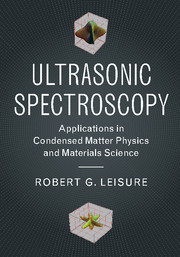Book contents
- Frontmatter
- Contents
- Preface
- 1 Introduction
- 2 Elasticity
- 3 Acoustic Waves in Solids
- 4 Experimental Methods
- 5 Elastic Constants
- 6 Ultrasonic Loss
- Appendix A Phase Shifts Due to Transducers and Bonds
- Appendix B Diffraction
- Appendix C Transducer Effects on Resonant Frequencies
- Appendix D Damped, Driven Oscillator and Complex Force Constant
- Appendix E Comparison of the Quasistatic and Experimental Temperature Dependence for Specific Cases
- References
- Index
1 - Introduction
Published online by Cambridge University Press: 19 June 2017
- Frontmatter
- Contents
- Preface
- 1 Introduction
- 2 Elasticity
- 3 Acoustic Waves in Solids
- 4 Experimental Methods
- 5 Elastic Constants
- 6 Ultrasonic Loss
- Appendix A Phase Shifts Due to Transducers and Bonds
- Appendix B Diffraction
- Appendix C Transducer Effects on Resonant Frequencies
- Appendix D Damped, Driven Oscillator and Complex Force Constant
- Appendix E Comparison of the Quasistatic and Experimental Temperature Dependence for Specific Cases
- References
- Index
Summary
The present chapter will serve as an overview of the material to be presented in the rest of the book. While it is hoped that the material will prove useful to all those involved in or interested in the use of ultrasound as a probe of condensed matter, a special effort is made to present the material in sufficient detail so as to be helpful to dedicated, upper-level undergraduate students and beginning graduate students. Scientists from several different disciplines are nowadays finding ultrasonic spectroscopy a useful tool, thus a strong background in solid-state physics, statistical physics, and quantum mechanics is not assumed of the readers. Brief background material is presented as needed. Several monographs have contributed to the advancement of ultrasonic spectroscopy, among them References [1, 2, 3]. The author is deeply indebted to those who have helped develop the field of ultrasonic studies of materials.
Chapter 2 deals with classical elasticity; the solid is treated as a continuum. The continuum approximation is valid for virtually all ultrasonic experiments. The present treatment of elasticity is more extensive than is usually found in books on ultrasonic techniques, but this more extensive treatment seems important if the researcher is to understand the widest implications of her/his ultrasonic research. Basic physical parameters in this chapter are stress (a two-index tensor), strain (a two-index tensor), and elastic constants (a four-index tensor, which by Hooke's Law connects stress and strain). Thus, many indices and sums over these indices appear frequently. For pedagogical reasons, it was decided not to use the elegant Einstein summation convention. For those new to the field, it seems better to write out the sums explicitly. The relation of elastic constants to thermodynamic potentials is derived. The condensed (Voigt) notation for stress, strain, and elastic constants is explained in detail. Coordinate transformations are treated. The form of the elastic constant matrix for each of the seven crystal systems is derived, as well as the form for the icosahedral quasicrystal.
- Type
- Chapter
- Information
- Ultrasonic SpectroscopyApplications in Condensed Matter Physics and Materials Science, pp. 1 - 3Publisher: Cambridge University PressPrint publication year: 2017



